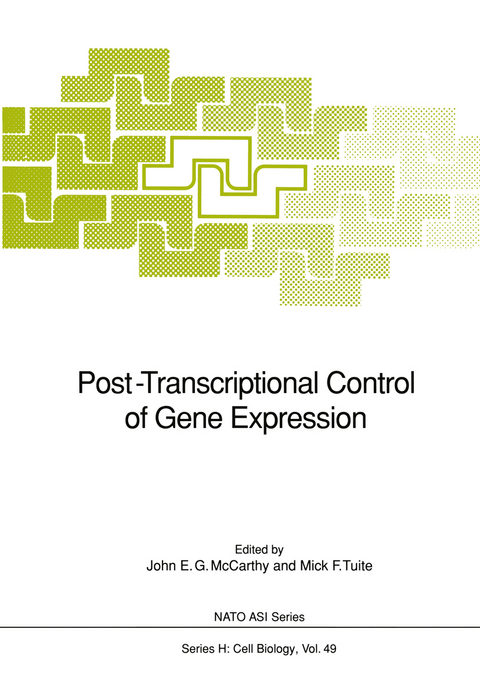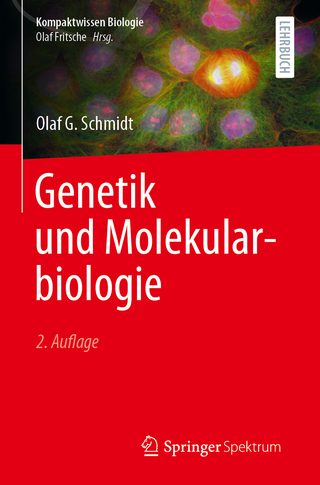
Post-Transcriptional Control of Gene Expression
Springer Berlin (Verlag)
978-3-642-75141-7 (ISBN)
The last ten years have witnessed a remarkable increase in our awareness of the importance of events subsequent to transcriptional initiation in terms of the regulation and control of gene expression. In particular, the development of recombinant DNA techniques that began in the 1970s provided powerful new tools with which to study the molecular basis of control and regulation at all levels. The resulting investigations revealed a diversity of post-transcriptional mechanisms in both prokaryotes and eukaryotes. Scientists working on translation, mRNA stability, transcriptional (anti)termination or other aspects of gene expression will often have met at specialist meetings for their own research area. However, only rarely do workers in different areas of post-transcriptional control/ regulation have the opportunity to meet under one roof. We therefore thought it was time to bring together leading representatives of most of the relevant areas in a small workshop intended to encourage interaction across the usual borders of research, both in terms of the processes studied, and with respect to the evolutionary division prokaryotes/eukaryotes. Given the breadth of topics covered and the restrictions in size imposed by the NATO workshop format, it was an extraordinarily difficult task to choose the participants. However, we regarded this first attempt as an experiment on a small scale, intended to explore the possibilities of a meeting of this kind. Judging by the response of the participants during and after the workshop, the effort had been worthwhile.
The book summarizes the latest results on the regulation of the gene expreesion which are interesting for molecular biologists as well as for biotechnologists.
mRNA Stability.- 1: Ribonucleases: diversity and regulation.- 2: Degradation of puf mRNA in Rhodobacter capsulatus and its role in the regulation of gene expression.- 3: Mutational analysis of a RNase E dependent cleavage site from a bacteriophage T4 mRNA.- 4: The role of a novel site-specific endoribonuclease in the regulated decay of E.coli mRNA - a model for growth-stage dependent mRNA stability in bacteria.- 5: Regulation of mRNA stability in yeast.- 6: Mutations involved in mRNA stability and in the length of their poly(A) tails in the yeast Saccharomvces cerevisiae.- 7: Rapid degradation of the c-fos proto-oncogene transcript.- 8: Post-transcriptional control of gene expression in chloroplasts.- 9: Differential mRNA stability: a regulatory strategy for Hsp70 synthesis.- Antisense Regulation.- 10: Post-transcriptional control of IS10 transposase expression: antisense RNA binding and other conformational changes affecting messenger RNA stability and translation.- 11: The antisense approach and early Xenoous development.- Transcriptional (Anti-)Termination.- 12: The role of boxA in transcription of ribosomal RNA operons of Escherichiacoli: changes in the Processi vi ty of RNA polymerase.- 13: Regulation of Lambda N-gene expression.- 14: Messenger RNA 3?end formation in E.coli and S. cerevisiae.- Translational Control.- 15: Culture conditions affect differently the translation of individual Escherichiacoli mRNAs.- 16: Post-transcriptional control in Escherichiacoli: the translation and degradation of mRNA.- 17: Control of translational initiation by mRNA secondary structure: a quantitative analysis.- 18: The role of ribosomal RNA in the control of gene expression.- 19: The phage f1 gene VII start site and its mutants reveal that translational coupling can conferfunction to inherently inactive initiation sites.- 20: Measurement of translation rates in vivo at individual codons and implication of these rate differences for gene expression.- 21: Regulation of gene expression by minor codons in Escherichiacoli: minor codon modulator hypothesis.- 22: A short review of scanning.- 23: Yeast mRNA structure and translational efficiency.- 24: Human fetal G?- and A?- globin mRNA and adult B-globin exhibit distinct translation efficiency and affinity for eukaryotic initiation factor 2.- 25: Effects of the 5?-leader sequence of tobacco mosaic virus RNA, or derivatives thereof, on foreign mRNA and native viral gene expression.- Translational Regulatory Circuits.- 26: Translational control of the cIII gene of bacteriophage lambda.- 27: The mom operon of bacteriophage Mu is regulated by a combination of transcriptional and translational controls.- 28: Mechanisms of ribosomal protein translational autoregulation.- 29: Translational feedback control in E.coli: the role of tRNAThr and tRNAThr-like structures in the operator of the gene for threonyl -tRNA synthetase.- 30: Translational control of the transcriptional activator GCN4 involves upstream open reading frames, a general initiation factor and a protein kinase.- 31: Translational control by arginine of yeast gene CPA1.- 32: Expression from polycistronic cauliflower mosaic virus pregenomic RNA.- 33: Polyadenylation of cauliflower mosaic virus RNA is controlled by promoter proximity.- 34: The HIV-1 Rev trans-activator is a sequence specific RNA binding protein.- 35: Control of protein synthesis by RNA regulators.- 36: Untranslated leader sequences and enhanced messenger RNA translational efficiency.- 37: Coordinate post-transcriptional regulation of ferritin and transferrin receptorexpression: the role of regulated RNA-protein interaction.- 38: Translation in yeast mitochondria: a review of general features and a case of mRNA- specific positive control.- 39: The yeast pyruvate kinase gene is regulated at multiple levels.- Biochemistry and Genetics of Translation.- 40: Initiation of protein synthesis in E.coli: the two crucial steps.- 41: The function of initiation factors in relation to mRNA-ribosome interaction and regulation of gene expression.- 42: Alternative translation and functional diversity of release factor 2 and lysyl-tRNA synthetase.- 43: Gene products that mediate translation initiation in yeast.- 44: Structure/function of mammalian initiation factors.- 45: Initiation factors involved in mRNA binding to ribosomes in Saccharomycescerevisiae.- 46: The eukaryotic mRNA cap binding protein (eIF-4E): phosphorylation and regulation of cell growth.- 47: Peptide chain initiation in animal cells: mechanism and regulation.- 48: New insights into an old problem: ternary complex (Met-tRNAf·eIF-2·GTP) formation in animal cells.- 49: Phosphorylation of initiation and elongation factors and the control of translation.- 50: Regulation of protein synthesis in mammalian systems by the guanine nucleotide exchange factor.- 51: Isolation of the lsd mutations in Saccharomycescerevisiae.- 52: Functional role and biochemical properties of yeast peptide elongation factor 3 (EF-3).- Translational Accuracy/Frameshifting.- 53: Translational Movements.- 54: Ribosomal frameshift and frame-jump sites as control points during elongation.- 55: Frameshifting in the expression of the trpR gene of Escherichiacoli.- 56: The ribosomal frame-shift signal of infectious bronchitis virus.- 57: Control of translational accuracy in yeast: the role of the Sa14 (Sup45)protein.- 58: HIV pol expression via a ribosomal frameshift.- Post-translational events.- 59: Protein modifications and mitochondrial import of yeast cytochrome c: an overview.
| Erscheint lt. Verlag | 3.12.2011 |
|---|---|
| Reihe/Serie | Nato ASI Subseries H: |
| Zusatzinfo | XIX, 652 p. |
| Verlagsort | Berlin |
| Sprache | englisch |
| Maße | 170 x 242 mm |
| Gewicht | 1143 g |
| Themenwelt | Studium ► 2. Studienabschnitt (Klinik) ► Humangenetik |
| Naturwissenschaften ► Biologie ► Mikrobiologie / Immunologie | |
| Naturwissenschaften ► Biologie ► Zellbiologie | |
| Schlagworte | DNA • Genaktivität • Gene • Gene activity • gene expression • gene regulation • genes • Genexpression • Genregulation • Regulation • RNA • termination • transcription • Translation |
| ISBN-10 | 3-642-75141-5 / 3642751415 |
| ISBN-13 | 978-3-642-75141-7 / 9783642751417 |
| Zustand | Neuware |
| Haben Sie eine Frage zum Produkt? |
aus dem Bereich


